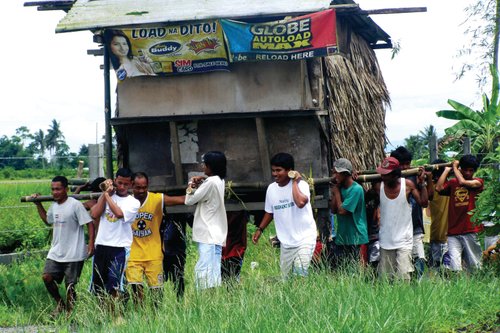#Aboutmyculture Challenge: Bayanihan, The Filipino Communal Spirit

Image Source
What's up?! This is going to be my very first writing challenge here on Steemit, so, please bear with me. I'm still trying to find my writing voice, if that is a thing. This guy definitely made some interesting points about making it here in Steemit and I am determined to improve myself, especially my writing skills.
This task asks for an article #aboutmyculture and I've decided to talk about a common cultural phenomenon called communal work or as we call it in the Philippines, 'Bayanihan.'
I chose this topic because, why the hell not? Steemit is supposed to be all about helping others in improving and bettering themselves, which I still think is a huge philosophy among its members, and I would like to talk about this parallel between Steemit and one of our defining characteristic as a people.
This is a special topic to me because I need to be reminded that people still do care about other people and that we all live in a community, whether be it online or in the real world. We are all one in this world and until we are able to colonize Mars and make it habitable, we are all stuck in this floating green rock together.
So, what is 'Bayanihan?'Well, it is the Philippine's take on a worldwide cultural phenomenon called communal work.
 Image Source
Bayanihan by Carlos “Botong” Francisco, 1962.
Image Source
Bayanihan by Carlos “Botong” Francisco, 1962.
Today, 'bayanihan' is called upon to gather the community, or the nation, for social initiatives, like disaster relief. Natural calamity is very common in the Philippines, which bolsters the community together and strengthen their ties even more.

Bayanihan is alive and well!
Image source: Bar Fabella from Stowawaymag.com
So, there you have it! My very first #challenge post!
What do you think about this 'Bayanihan' concept? Let me know in the comments!
Check out my other posts here:
References:
Barlow, S. (2016, October 3). Bayanihan: The Spirit of the Philippines. Retrieved March 26, 2018, from http://stowawaymag.com/2016/10/03/bayanihan-the-spirit-of-the-philippines/
Wikipedia contributors. (2018, February 25). Communal work. In Wikipedia, The Free Encyclopedia. Retrieved 21:03, March 26, 2018, from https://en.wikipedia.org/w/index.php?title=Communal_work&oldid=827632313

Congratulations @johannrandall! You have completed some achievement on Steemit and have been rewarded with new badge(s) :
Click on any badge to view your own Board of Honor on SteemitBoard.
To support your work, I also upvoted your post!
For more information about SteemitBoard, click here
If you no longer want to receive notifications, reply to this comment with the word
STOP